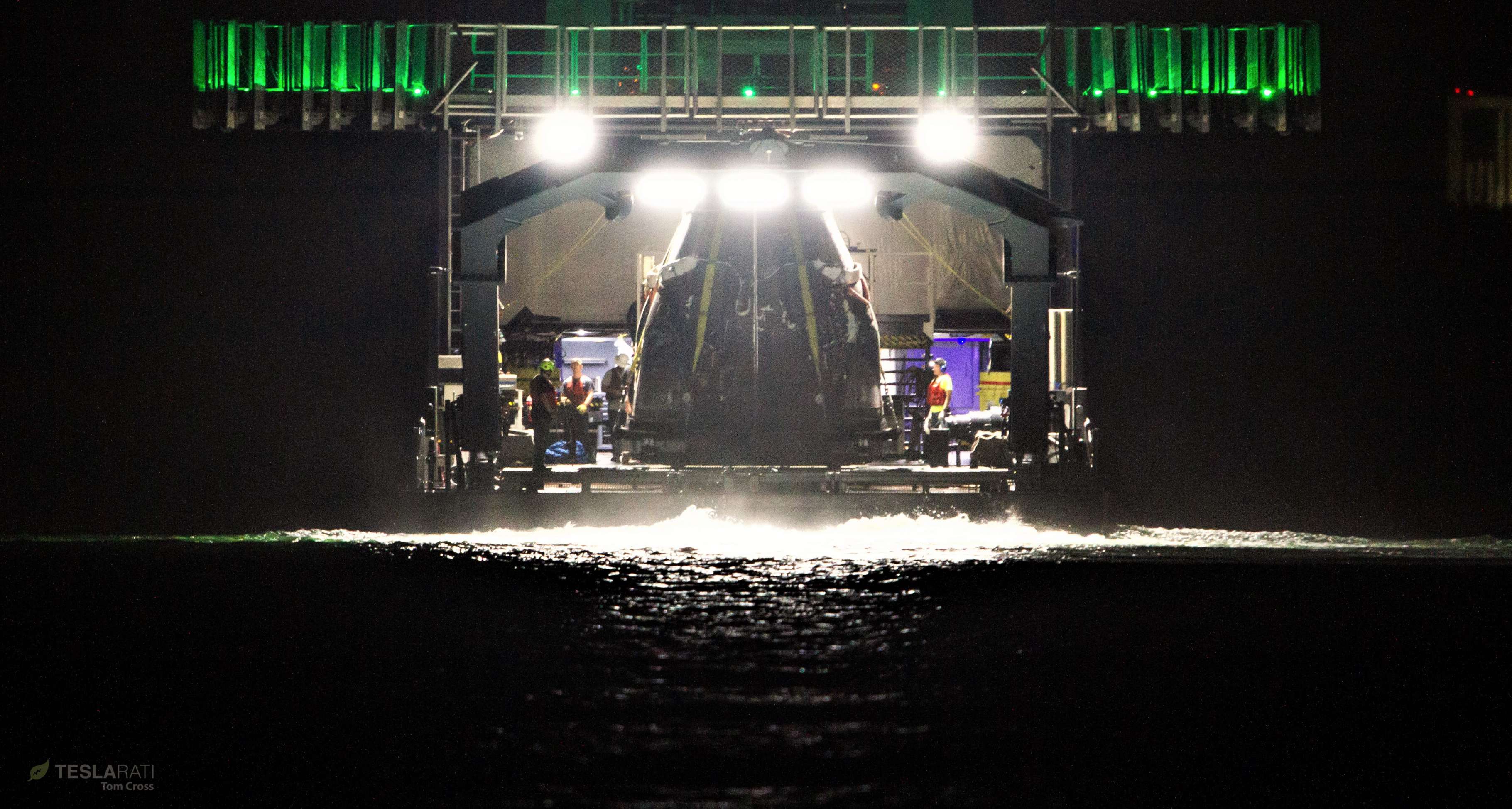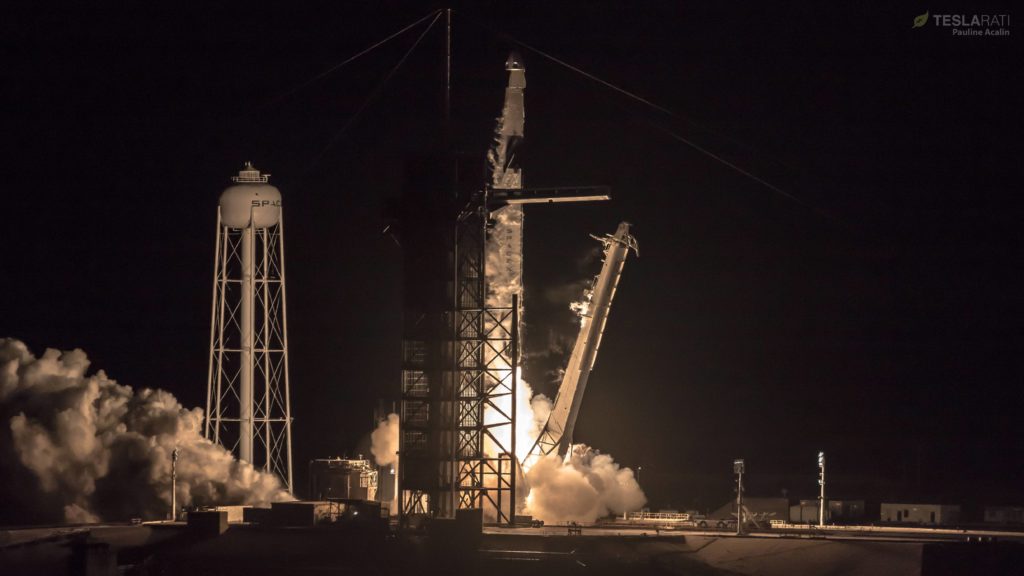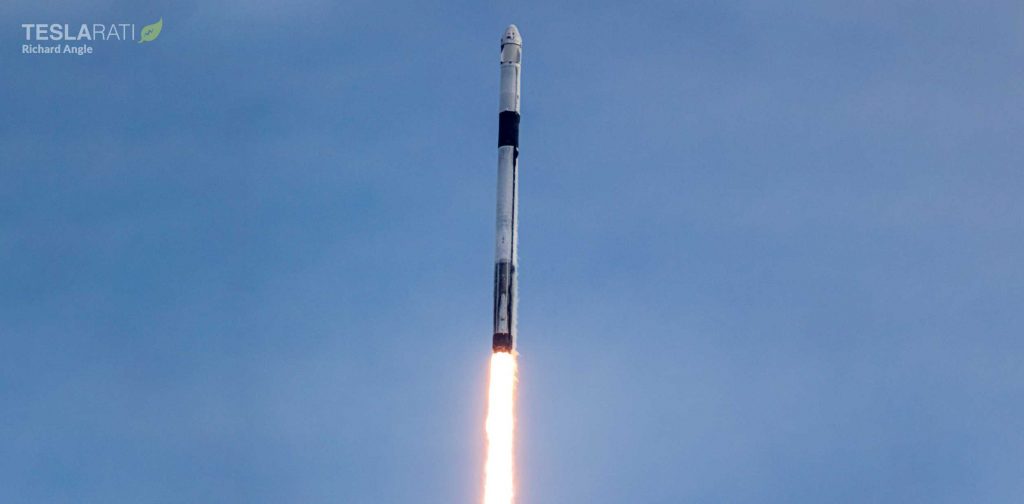

News
SpaceX Crew Dragon spacecraft sails home after flawless in-flight abort test
SpaceX’s newest Crew Dragon spacecraft has successfully returned to port aboard one of the company’s dedicated recovery vessels, neatly wrapping up what appears to have been a completely flawless in-flight abort (IFA) test.
Designed to prove that Crew Dragon can safely escape a failing Falcon 9 rocket at essentially any point from the launch pad to orbit, SpaceX voluntarily chose to perform a full-fidelity IFA test – something NASA left up to both it and Boeing. Boeing instead decided to extrapolate from a pad abort test – which SpaceX completed in 2015 – and a presumably large number of digital simulations to verify that Starliner would survive an in-flight abort.
To be clear, NASA is explicitly okay with this, but space agency officials did not shy away from openly embracing the superiority of integrated flight testing at several points both before, during, and after SpaceX’s second Crew Dragon launch. Although it will almost certainly remain (publicly) unsaid, there should be little doubt that for astronauts scheduled to fly on either Crew Dragon and Starliner, the successful completion of in-flight abort and pad abort tests almost certainly engenders at least a little more confidence in the vehicle they will be entrusting their lives to.
It’s worth noting that although NASA argues – perhaps soundly – that digital modeling, a pad abort test, and an orbital flight test are enough to determine whether any given spacecraft is safe enough to launch US astronauts, the unspoken reality – or at least a large part of it – is that cost is a major concern. At this point in time, NASA’s Commercial Crew Program (CCP) contracts are expected to cost a total of $3.1B for SpaceX and $5.1B for Boeing – both including at least four total orbital launches of their respective spacecraft.
In simpler terms, despite the fact that SpaceX has received a full $2 billion (~40%) less than Boeing to accomplish the same tasks in the same time, SpaceX’s Crew Dragon completed a flawless orbital launch debut and space station rendezvous with Crew Dragon almost 10 months before Boeing’s Starliner suffered a serious partial failure in space. Simultaneously, for $2 billion less, SpaceX has now given NASA a seemingly flawless full-up in-flight abort test of Crew Dragon before the space agency will fully entrust the spacecraft with the safety of its astronauts.
In the last 10 or so weeks, Boeing has thus suffered a minor Starliner parachute failure, a far more concerning spacecraft failure during its first orbital flight test (OFT), has no plans to perform an in-flight abort test, and nevertheless still wants Starliner’s next launch to carry NASA astronauts.
A clear path ahead
SpaceX, on the other hand, has now completed two seemingly-flawless integrated launches of Crew Dragon on a Falcon 9 rocket – one of which successfully rendezvoused with the ISS and returned to Earth; the other of which has now proven that Crew Dragon can whisk astronauts to safety from a failing supersonic rocket. SpaceX says it will carefully inspect capsule C205 and eventually refurbish the spacecraft, although it’s entirely unclear what kind of mission the company could foreseeably reuse it on in the near future.


Speaking shortly after Crew Dragon’s second flawless launch, SpaceX CEO Elon Musk said that he had spoken with NASA administrator Jim Bridenstine just prior to the post-launch press conference and together came up with a response to the most obvious question: when will SpaceX fly astronauts? In short, Musk was almost certain that all the hardware needed for the Demo-2 astronaut test flight – Falcon 9 booster, F9 upper stage, Crew Dragon capsule C206, and a Dragon trunk – will be completed, tested, and delivered to Cape Canaveral by late-February 2020.
If everything goes exactly as planned, NASA – prior to launch – indicated that an early-March 2020 launch was actually within reach. After launch, Musk tempered expectations, stating that SpaceX would almost certainly launch its first NASA astronauts sometime in Q2 – perhaps as early as April. Regardless, it looks like we wont have to wait more than a few months to find out.
Check out Teslarati’s Marketplace! We offer Tesla accessories, including for the Tesla Cybertruck and Tesla Model 3.
News
Tesla begins Robotaxi certification push in Arizona: report
Tesla seems serious about expanding its Robotaxi service to several states in the coming months.

Tesla has initiated discussions with Arizona transportation regulators to certify its driverless Robotaxi service in the state, as per a recent report from Bloomberg News. The move follows Tesla’s launch of its Robotaxi pilot program in Austin, Texas, as well as CEO Elon Musk’s recent comments about the service’s expansion in the Bay Area.
The Arizona Department of Transportation confirmed to Bloomberg that Tesla has reached out to begin the certification process for autonomous ride-sharing operations in the state. While details remain limited, the outreach suggests that Tesla is serious about expanding its driverless Robotaxi service to several territories in the coming months.
The Arizona development comes as Tesla prepares to expand its service area in Austin this weekend, as per CEO Elon Musk in a post on X. Musk also stated that Tesla is targeting the San Francisco Bay Area as its next major market, with a potential launch “in a month or two,” pending regulatory approvals.
Tesla first launched its autonomous ride-hailing program on June 22 in Austin with a small fleet of Model Y vehicles, accompanied by a Tesla employee in the passenger seat to monitor safety. While still classified as a test, Musk has said the program will expand to about 1,000 vehicles in the coming months. Tesla will later upgrade its Robotaxi fleet with the Cyercab, a two-seater that is designed without a steering wheel.
Sightings of Cybercab castings around the Giga Texas complex suggests that Tesla may be ramping the initial trial production of the self-driving two-seater. Tesla, for its part, has noted in the past that volume production of the Cybercab is expected to start sometime next year.
In California, Tesla has already applied for a transportation charter-party carrier permit from the state’s Public Utilities Commission. The company is reportedly taking a phased approach to operating in California, with the Robotaxi service starting with pre-arranged rides for employees in vehicles with safety drivers.
News
Tesla sets November 6 date for 2025 Annual Shareholder Meeting
The automaker announced the date on Thursday in a Form 8-K.

Tesla has scheduled its 2025 annual shareholder meeting for November 6, addressing investor concerns that the company was nearing a legal deadline to hold the event.
The automaker announced the date on Thursday in a Form 8-K submitted to the United States Securities and Exchange Commission (SEC). The company also listed a new proposal submission deadline of July 31 for items to be included in the proxy statement.
Tesla’s announcement followed calls from a group of 27 shareholders, including the leaders of large public pension funds, which urged Tesla’s board to formally set the meeting date, as noted in a report from The Wall Street Journal.
The group noted that under Texas law, where Tesla is now incorporated, companies must hold annual meetings within 13 months of the last one if requested by shareholders. Tesla’s previous annual shareholder meeting was held on June 13, 2024, which placed the July 13 deadline in focus.
Tesla originally stated in its 2024 annual report that it would file its proxy statement by the end of April. However, an amended filing on April 30 indicated that the Board of Directors had not yet finalized a meeting date, at least at the time.
The April filing also confirmed that Tesla’s board had formed a special committee to evaluate certain matters related to CEO Elon Musk’s compensation plan. Musk’s CEO performance award remains at the center of a lengthy legal dispute in Delaware, Tesla’s former state of incorporation.
Due to the aftermath of Musk’s legal dispute about his compensation plan in Delaware, he has not been paid for his work at Tesla for several years. Musk, for his part, has noted that he is more concerned about his voting stake in Tesla than his actual salary.
At last year’s annual meeting, TSLA shareholders voted to reapprove Elon Musk’s compensation plan and ratified Tesla’s decision to relocate its legal domicile from Delaware to Texas.
Elon Musk
Grok coming to Tesla vehicles next week “at the latest:” Elon Musk
Grok’s rollout to Tesla vehicles is expected to begin next week at the latest.

Elon Musk announced on Thursday that Grok, the large language model developed by his startup xAI, will soon be available in Tesla vehicles. Grok’s rollout to Tesla vehicles is expected to begin next week at the latest, further deepening the ties between the two Elon Musk-led companies.
Tesla–xAI synergy
Musk confirmed the news on X shortly after livestreaming the release of Grok 4, xAI’s latest large language model. “Grok is coming to Tesla vehicles very soon. Next week at the latest,” Musk wrote in a post on social media platform X.
During the livestream, Musk and several members of the xAI team highlighted several upgrades to Grok 4’s voice capabilities and performance metrics, positioning the LLM as competitive with top-tier models from OpenAI and Google.
The in-vehicle integration of Grok marks a new chapter in Tesla’s AI development. While Tesla has long relied on in-house systems for autonomous driving and energy optimization, Grok’s integration would introduce conversational AI directly into its vehicles’ user experience. This integration could potentially improve customer interaction inside Tesla vehicles.
xAI and Tesla’s collaborative footprint
Grok’s upcoming rollout to Tesla vehicles adds to a growing business relationship between Tesla and xAI. Earlier this year, Tesla disclosed that it generated $198.3 million in revenue from commercial, consulting, and support agreements with xAI, as noted in a report from Bloomberg News. A large portion of that amount, however, came from the sale of Megapack energy storage systems to the artificial intelligence startup.
In July 2023, Musk polled X users about whether Tesla should invest $5 billion in xAI. While no formal investment has been made so far, 68% of poll participants voted yes, and Musk has since stated that the idea would be discussed with Tesla’s board.
-

 Elon Musk1 week ago
Elon Musk1 week agoTesla investors will be shocked by Jim Cramer’s latest assessment
-

 Elon Musk3 days ago
Elon Musk3 days agoElon Musk confirms Grok 4 launch on July 9 with livestream event
-

 Elon Musk14 hours ago
Elon Musk14 hours agoxAI launches Grok 4 with new $300/month SuperGrok Heavy subscription
-

 News7 days ago
News7 days agoTesla Model 3 ranks as the safest new car in Europe for 2025, per Euro NCAP tests
-

 Elon Musk2 weeks ago
Elon Musk2 weeks agoA Tesla just delivered itself to a customer autonomously, Elon Musk confirms
-

 Elon Musk1 week ago
Elon Musk1 week agoxAI’s Memphis data center receives air permit despite community criticism
-

 Elon Musk2 weeks ago
Elon Musk2 weeks agoTesla’s Omead Afshar, known as Elon Musk’s right-hand man, leaves company: reports
-

 News2 weeks ago
News2 weeks agoXiaomi CEO congratulates Tesla on first FSD delivery: “We have to continue learning!”

















